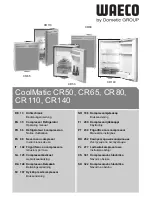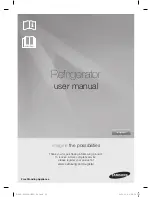
– 39 –
WARNING:
When the refrigerator is plugged in, 120
VAC is always present at the inverter.
Note:
Certain voltmeters will not be able to read
voltage output from the inverter. If no voltage or
erratic voltage is measured, it does not necessarily
indicate a faulty inverter.
The inverter receives 120 VAC line-in from the power
supply. The inverter converts this single-phase, 60
Hz, 120 VAC into 3-phase, 240 VAC, with frequency
variations between 57 Hz and 104 Hz. This voltage
is delivered to the compressor through 3 lead wires.
Each wire will carry identical voltage and frequency.
Note:
The compressor leads must be connected to
measure voltage output. If the compressor wires are
not connected, or if an open occurs in one of the 3
lead wires or in the compressor, the inverter will stop
voltage output.
Remove the Phillips-head screw from the
5.
inverter.
Lift and rotate the inverter counterclockwise.
6.
Disconnect the compressor harness from the
7.
compressor terminals.
Tab
Lip
Disconnect
When checking inverter voltage output, connect
the test-meter leads to any 2 of the 3 compressor
lead wires at the inverter plug (plug should be
connected). The same reading should be measured
between any 2 of the 3 wires.
The inverter controls compressor speed by
frequency variation and by Pulse Width Modulation
(PWM). Changing frequency and PWM will cause
an effective voltage between 80 and 240 VAC to be
received at the compressor.
• Low speed (1710 rpm) - 57 Hz
• Medium speed (2100 rpm) - 70 Hz
• High speed (3120 rpm) - 104 Hz
The inverter receives commands from the main
control board. The main control board will send
a PWM run signal from the J15 connector of 4-6
VDC effective voltage to the inverter (all wires must
be connected). The inverter will select compressor
speed (voltage output) based on this signal.
The main control board will only send a run signal to
the inverter when the compressor should be on.
Note:
When measuring signal voltage (from the
main control board) at the inverter, a reading of 4-6
VDC will be measured with all wires connected. If the
inverter wiring is disconnected, the board output will
measure between 10-12 VDC.
The inverter will monitor compressor operation and
if the compressor fails to start or excessive current
draw (4 amps maximum) is detected, the inverter
will brie
fl
y stop voltage output. The inverter will then
make 12 consecutive compressor start attempts
(once every 12 seconds). After 12 attempts, if the
compressor has not started, an 8-minute count
will initiate. After the 8-minute count, the inverter
will attempt to start the compressor again. If the
compressor starts, normal operation will resume.
If the compressor fails to start, this process will be
repeated. Removing power to the unit will reset
the inverter count. When power is restored, the
inverter will attempt to start the compressor within
8 minutes.
The inverter has a built-in circuit protection to
guard against damage from a failed or shorted
compressor. However, if a failed compressor is
diagnosed, order a new compressor and inverter.
If the compressor fails to start after replacement,
replace the inverter.
















































